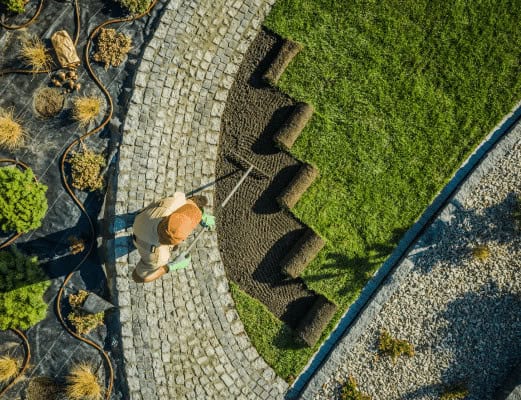Have you liked our Facebook page yet? No? Well, it’s high time you do. Check us out, like the page, tell a friend, and stay tuned for more updates from Pitt Landscape. Here’s to a good old-fashioned American summer!
It’s the most wonderful time of the year (for landscapers, anyway). The sun’s sticking around longer every day, and things have been heating up for us. Speaking of which, have you thought about your sprinkler system lately? Whether you have or you haven’t had much time, we’ve got your back.
In the mean time, we thought we’d share some photos of what we’ve been up to lately.
Summer’s here. Time to take advantage of the sunny days and the cool nights by extending your indoor living space to the outdoors. Whether you love to entertain or simply want an oasis where you can get away from indoor distractions, we have a few outdoor living space ideas to spruce up your lawn and garden area.
Who Doesn’t Love Barbecue?
Whether you’re working with a simple hibachi or you prefer the convenience of a full-sized kitchen, adding a barbecue area outdoors is a tried-and-tested way to add style to your home. You may even forget that you have a kitchen indoors! Add counter space and a small refrigerator to streamline meal preparation and serving.
Sit in Style
Don’t be tempted to simply scatter a dozen lawn chairs all over the patio when you have guests. Low concrete walls and nooks on a patio can act as room dividers, turning your barbecue area into an extension of your living room. Add a pergola and throw in some outdoor sofas and you have an elegant alternative to the adult’s table.
Keep It Private
Strategically positioned lattices and pergolas can screen an exposed roof or area of your garden while allowing the space to breathe. A free-floating stone wall can also create a border and add charm while giving you privacy. Create an outdoor breakfast nook by tucking a small table and chairs into the corner of the backyard, separated by tall hedges or a stone fence, where you can enjoy your morning coffee or have a private chat.
Make a Game Out of It… Literally
Remember the gigantic chessboard from Harry Potter? While you don’t need to get that extreme, take oversized granite slabs and position them in an empty corner of the yard to add some life. Then find (or make) some oversized chess or checker pieces and you’ll take couples game night to new levels!
Think Outside the Box
More specifically, think outside the box that is your home. You might not want to completely mimic the style of the place where you spend most of your time. Start using your imagination and flex your creativity. Think of a place that inspires you, like a luxury resort you may have visited. Then choose which elements you like best and incorporate them into your design. Consider separate destinations, too, like a pavilion and a pool. These can provide features for everyone to enjoy while keeping things together yet separate.
Play with Ambience
A fireplace can take an outdoor living space from normal to lavish, and it’s the perfect gathering spot for the whole family, whether you’re cozying up together on a cool evening or roasting marshmallows.
Ready to make the most of your outdoor living potential? Contact Pitt Landscape today, and let’s turn your backyard into the ultimate space for relaxation, entertaining, and enjoying life to the fullest. Let us help you expand your living area and redefine outdoor living.
The April showers have arrived, and right on time. When’s the last time you checked the foundation of your home for water damage? If you’ve done so recently and have found pooling water, wet insulation, or black mold and rot on the floor, it’s time to start thinking about some major repairs. Mold could indicate that your sub-flooring is rotting which might leave a huge hole in your floor! But before you start replacing the flooring, first things first: You need to address the water issue. And your landscaping may be the enemy.
Landscaping can act as a natural filter, because water follows the path of least resistance to the lowest levels of any given property. Poor landscaping can facilitate water entering your home’s foundation as topsoils, mulch, and loose rocks filter rain and excess water into the foundation if placed too closely to your home. Plastic vapor barriers can help protect against water, though over time the material can fail, which means you’ll need to keep replacing the barriers. Using a heavy clay soil that’s compacted and sloped as the first layer of your landscaping will help to drain water away from your home. And adding a bed of mulch, as well as a layer of topsoil for plants, will provide even more protection. Making sure that concrete patios, driveways, or walks slope downwards will also encourage proper draining.
Drains can also be the culprits. Rain gutter drains need to be directed no less than six feet from your foundation, though you may need to extend them further if your house has a sloping yard or sits on a hillside. You might consider burying unappealing drains just under your yard’s surface. Before you start digging, however, be sure to call 811 so a professional can mark off any water lines, buried cables, or gas lines. The free service could save you from accidentally hitting and breaking one of them.
Consider burying a French drain around your foundation’s perimeter, all the way down to the footing. French drains comprise flexible pipes that are full of holes, which allow for water to drain properly. A sediment sock also covers the pipes, which keeps silt from entering the system. After a trench is dug, crushed stone is placed inside, followed by the drain tile and a second layer of stone. Finally, a layer of compacted topsoil is placed in the trench to match ground level. Excess water is then directed to the drain before it can enter your foundation. If your home’s perimeter is too low to be able to install such a system, you can also install an exterior sump pump to help raise water to a point where gravity can take over.
Don’t let poor landscaping put your property at risk—reach out to Pitt Landscape today and let us help you create a safer, more resilient outdoor environment.
It’s never too late to start planning your spring flower garden. Your garden says as much about you and the way you run your home as your fashion and hygiene say about how you take care of yourself. It’s important to keep things fresh. You are what you plant. And every garden should be treated as a highly personal work of art. We have tips for days, but here’s a primer on design principles that will make your garden pop.
Show Off Your All-Stars
The right plant can draw attention to your home and be the talk of the neighborhood. Certain plants can play off other plants, providing an ebb and flow to your garden so that those who are particularly showy when in bloom can shine while others blend into the background and highlight them. Those are your all-stars. We’re fans of using backdrops like hedge rows and fences to highlight shapes and colors. Your house itself can even be used as a backdrop.
Island beds are another option. While they don’t have a backdrop to serve as display, they’re easily viewed from all angles, where backdrops are usually only viewed from the front. Whichever style you choose, consider using a focal point like a small bench or a statue to draw attention to your masterpiece. Just stay away from tacky garden gnomes.
Play with Texture
Texture is important to consider when planning your garden as well. Greens, flowers, trees, bushes, rocks—all of these can play a major role in making sure your garden both pleases and engages the eye. Nobody wants to look at a bed that only has one kind of flower. The possibilities are endless. If you’re going with in island bed, consider an anchor piece, such as a tree, shrub, or large perennial. You can even go with a statue, large container, or a bench. Play with geometrical shapes or use bright, colorful flowers as borders for walkways.
Color scheme is also important to keep in mind as you move forward with designing your garden. We could go on for ages about our favorite colors and color combinations; it’s all a matter of personal preference. Go the more traditional route or get creative with your palette. Either way, we’re sure it’ll pay off!
Keep It Symmetrical
This takes a bit of planning, because moving plants multiple times over the course of a season doesn’t promote growth. It’s best to come up with a solid game plan and to stick with it. Keep in mind that yardsticks aren’t just for vegetables. You can use a yardstick to make sure plants are evenly spaced and sit in straight rows. But you can also play with other designs, too.
It’s important to layer, too. Place taller, sun-loving plants and shrubs in the back and keep shorter annuals and perennials in the front. And be sure to reserve a seat for some salvias in the middle. Once you’ve determined height and arranged accordingly, you can arrange types in small groups of odd numbers for the greatest visual impact. Single flowers by themselves won’t stand out at all. Give them friends to play with!
In the end, what works for you may not work for Mr. or Mrs. Next-Door-Neighbor. Every garden and everyone’s personal tastes are unique. But by going into the season with a garden design ideas in mind can help you create and cultivate a garden that’s sure to turn some heads. You might even consider putting up warning signs. Just make sure they don’t clash with your work of art. Contact Pitt Landscape today and let us help you bring your vision to life. Together, we’ll make your garden the centerpiece of your home.
Get in Touch












